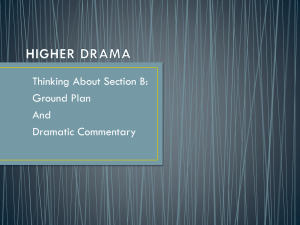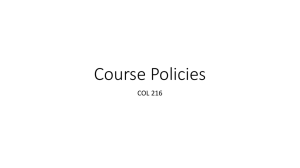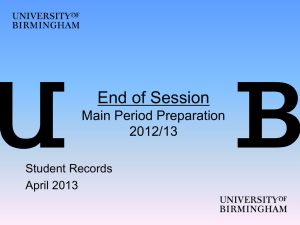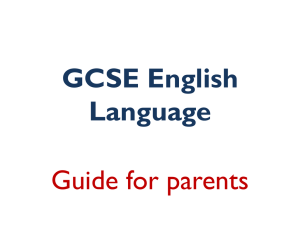UG End of session training presentation (PPT
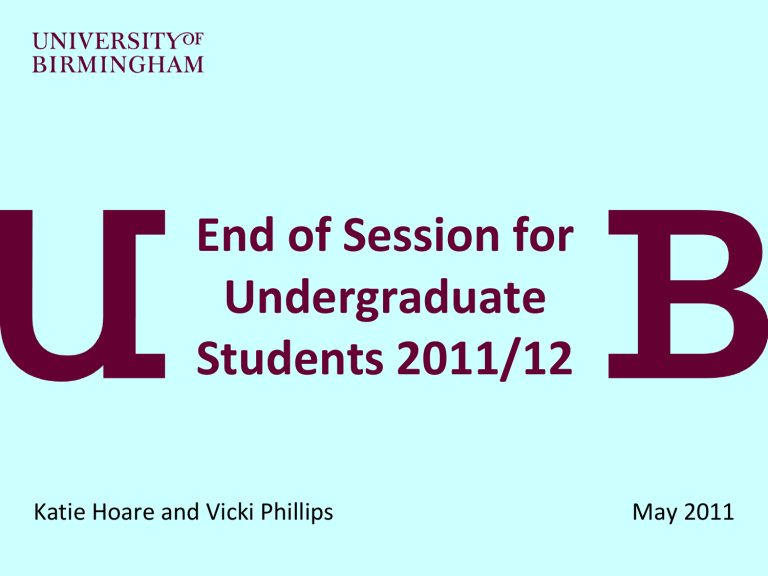
End of Session for
Undergraduate
Students 2011/12
Katie Hoare and Vicki Phillips May 2011
Session Outline
Check module marks and recommendations
Useful marks BOXI reports
ARTs: progress decisions /degree classifications
Dealing with End of Session errors
Useful end of session BOXI reports
Check module marks and recommendations
Before processing students for end of session, check that all modules have marks and recommendations
ME05 Calculate Marks and Recommendations page marks and recommendations for individual modules
ES04 Module Registrations page (via M button) marks and recommendations for all modules for individual students
Useful marks BOXI reports
Reports located in BIRMS Students/Modules and
Component Marks
Missing Marks reports to identify where students have marks missing
Module marks grid reports to check the marks that are in BIRMS and identify students with marks missing
Results Grid (No ARTs)
Assessment Periods
Period of the Academic year in which
modules are assessed
marks are recorded
an Exam Board recommendation is made
Two assessment periods applicable for UG:
Main
Supplementary
Assessment Periods
Main
Standard UG – main examination period
May/June
First assessment opportunity
Second sit opportunity for Resit, Repeat and
First Sit modules carried from the previous year
Assessment Periods
Supplementary
Reassessment period, usually
August/September
Second (usually final) assessment opportunity
First sit opportunity for students with mitigation
ARTs: progress decisions and degree classifications
ART: Academic Review Type = exam board recommendation/decision
Progress decisions
calculated in BIRMS for most students
dependent on module recommendations
Degree classifications
calculated in BIRMS for most students who have successfully completed dependent on marks
Progress decisions (non-final years)
Demonstration of progress decision ARTs:
ART A – Proceed
ART D – Proceed with Outstanding Requirements
ART C – Review
ART K – Repeat Year (or part of year) internally
ART J – External Resit/Sit
ART E – Proceed and Transfer Programme
Specify data in ES01 (1)
Specify the data to be processed in ES01
Progression and Award Processing page
Select:
Academic Year (academic session)
Assessment Period, one of
Main
Supplementary
Specify data in ES01 (2)
Then specify one of:
Programme and Programme Year
Cohort
Speciality
To process students individually (optional):
specify a Student ID number,
or search for a student by last name
Specify data in ES01 (3)
Other options:
Excluding students who already have an ART
Processing anonymously
Student statuses can be excluded from processing if selected from the Status to exclude drop-down list (optional).
Finally, press [Enter Decisions].
Progress decisions
ART A - Proceed
All modules:
must have marks and recommendations
must have module recommendations of P
ART A will calculate in BIRMS
Upon release it will release marks and progress the student into the next academic year and onto the next programme year
Progress decisions
ART D – Proceed with Outstanding
Requirements (1)
All modules:
must have marks and recommendations
100 or 110 credits worth of modules = P
10 or 20 credits worth of failed modules = SE,
SU, ME, M, RP or RS
ART D will calculate in BIRMS
Progress decisions
ART D – Proceed with Outstanding
Requirements (2)
Upon release it will release marks and progress the student into the next academic year and onto the next programme year
Supplementary registrations will be created for the failed modules if the module recommendation was SE, SU, ME or M
Progress decisions
ART D – Proceed with Outstanding
Requirements (3)
If the module recommendation was RP or RS the student will be automatically registered for the module in the next academic year with the correct module status
If the module recommendation was M and the student is sitting it in the following academic session you will need to manually register the student for the module as a Sit and ignore their End of Session entry in the Supplementary period
Progress decisions
ART D – Proceed with Outstanding
Requirements (4)
If Year Abroad mark is unavailable
Enter a mark of 0 M
Select ART D
Progress decisions
ART C - Review
All modules:
must have marks and recommendations
Less than 100 credits = (P) Pass
Failed modules = SE, SU, ME or M
ART C will calculate in BIRMS
Upon release it will release marks but will not progress the student into the next academic year or onto the next programme year
Supplementary registrations will be created for the failed modules
Progress decisions
ART K – Repeat Year (or part of year) internally
If the Exam Board decision is for the student to repeat the year internally rather than re-take the assessments in the supplementary period
Manually select an ART K
(module recommendations = RP or M)
Upon release module registrations will be generated for the following year
Progress decisions
ART J – External Resit/Sit
If the decision is for the student to repeat the year externally rather than re-take the assessments in the supplementary period
Manually select an ART J
(module recommendations RS or M)
Upon release module registrations will be generated for the following year
Progress decisions
ART E – Proceed and Transfer
Programme
ART E will calculate for Year 2 students on
BEng/MEng or BSc/MSci programmes:
Who have enough credits to proceed (100 credits)
Students may have resits to take, either in the
Supplementary Examination period or during the next academic year
Check transfer programme auto-selected, and manually reselect if necessary
Will auto-select M.Eng or M.Sci if student has a stage
2 weighted mean mark of at least 55%
ARTs for final year students
Demonstration of final year ARTs:
ART B – Award Qualification (Successful
Completion
ART G – Award Alternative Qualification
Degree classifications
ART B – Award Qualification (1)
(Successful Completion)
ART B will calculate for all students who have satisfied the requirements of their programme
ART B auto-calculation in BIRMS will take into account
Borderline
Adjusted Regulations
Degree classifications
ART B – Award Qualification (2)
(Successful Completion)
Detailed information about Distribution of Module Classes
(profiling) is available in the Code of Practice on Taught
Programme and Module Assessment
Detailed information about Adjusted Regulations is available in
Code of Practice on Adjusted Regulations for Bachelors
Degrees
Code of Practice on Adjusted Regulations for
Undergraduate Masters Degrees
Degree classifications
ART B – Award Qualification (3)
(Successful Completion)
Additional Undergraduate programmes for which
ART B can now be auto-calculated from this year
Intercalated BMedSc
LLB for Graduates
MBChB
And Direct Entry students
Degree classifications
ART B – Award Qualification (4)
(Successfully Completion)
For UG Affiliated students:
Enter marks for all modules
If it has been agreed that the student will not be taking the assessment for a module, enter o mark of N o module recommendation of N (No Mark
Required)
ART B should be selected, even if students have not passed all their modules
Degree classifications
ART B – Award Qualification (5)
(Successfully Completion)
If the Exam Board makes a recommendation notwithstanding regulations where mitigation is not involved, this will need to go to the Progress and Awards
Board for approval.
The result is provisional until ratified by PAB.
Leave the ART field and Degree Classification blank until approval is confirmed. Otherwise, the result will be released with the other ARTs and viewable by the student on the portal.
Do not use an ART Z.
Degree classifications
ART B – Award Qualification (6)
(Successfully Completion)
ART B will not calculate for students who have not achieved sufficient credits to satisfy the requirements of their programme
BIRMS will display a message to say ‘ Student has not achieved sufficient credits ’.
Degree Classifications
ART G – Award Alternative
Qualification
For students who have not satisfied the requirements of their programme
manually apply ART G (Award Alternative
(Lower) Qualification)
select Alternative Qualification programme from drop-down list
Dealing with errors
Examples of common errors:
Missing mark
Missing recommendation
Student has a Hold
Student has too many credits
Using End of Session BOXI reports
Demonstration
Locating reports
Instructions
Running reports
Scheduling reports
Downloading reports
Manipulating downloaded report data




